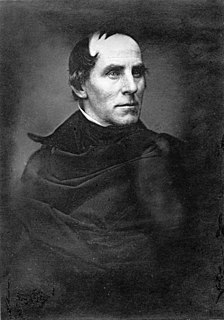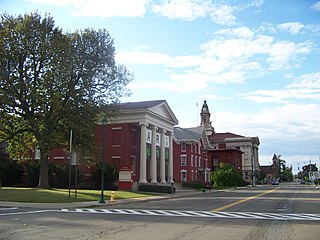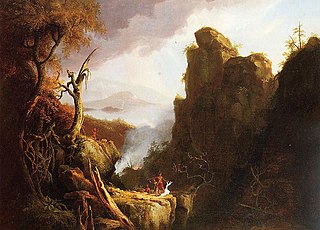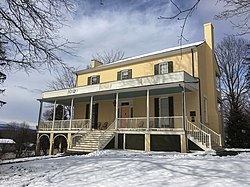
Greenport is a town in Columbia County, New York, United States. The population was 4,165 at the 2010 census. The town is on the west border of the county and surrounds the city of Hudson on three sides. US 9 passes through the town.

Catskill is a village in Greene County, New York, United States. The population was 4,081 at the 2010 census, down from 4,392 at the 2000 census. The village is in the northeast part of the town of Catskill. Catskill is the county seat of Greene County.

Catskill is a town in the southeast part of Greene County, New York, United States. The population was 11,775 at the 2010 census. The western part of the town is in the Catskill Park. The town contains a village, also called Catskill. The village of Catskill has a well-defined Main Street. There is a public boat launch on the Hudson River called Dutchman's Landing.

Frederic Edwin Church was an American landscape painter born in Hartford, Connecticut. He was a central figure in the Hudson River School of American landscape painters, best known for painting large landscapes, often depicting mountains, waterfalls, and sunsets. Church's paintings put an emphasis on realistic detail, dramatic light, and panoramic views. He debuted some of his major works in single-painting exhibitions to a paying and often enthralled audience in New York City. In his prime, he was one of the most famous painters in the United States.

The Hudson River School was a mid-19th century American art movement embodied by a group of landscape painters whose aesthetic vision was influenced by Romanticism. The paintings typically depict the Hudson River Valley and the surrounding area, including the Catskill, Adirondack, and White Mountains. Works by the second generation of artists associated with the school expanded to include other locales in New England, the Maritimes, the American West, and South America.

Thomas Cole was an Anglo-American painter known for his landscape and history paintings. One of the major 19th-century American painters, he is regarded as the founder of the Hudson River School, an American art movement that flourished in the mid-19th century. Cole's work is known for its romantic portrayal of the American wilderness.

Jasper Francis Cropsey was an important American landscape artist of the Hudson River School.

North–South Lake is an 1,100-acre (4.4 km²) state campground in the Catskill Forest Preserve near Palenville, New York operated by the New York State Department of Environmental Conservation near the site of the historic Catskill Mountain House overlooking the Hudson River. The escarpment on which the lakes are located is at 2,250 feet, 1,700 feet above the valley floor, providing a view of five states in clear weather.

Olana State Historic Site is a historic house museum and property in Greenport, New York, near the city of Hudson. The estate was home to Frederic Edwin Church (1826–1900), one of the major figures in the Hudson River School of landscape painting. The centerpiece of Olana is an eclectic villa which overlooks parkland and a working farm designed by the artist. The residence has a wide view of the Hudson River Valley, the Catskill Mountains and the Taconic Range. Church and his wife Isabel (1836–1899) named their estate after a fortress-treasure house in ancient Greater Persia, which also overlooked a river valley.

Kaaterskill Falls is a two-stage waterfall on Spruce Creek in the eastern Catskill Mountains of New York, between the hamlets of Haines Falls and Palenville in Greene County. The two cascades total 260 feet in height, making Kaaterskill Falls one of the highest waterfalls in New York, and one of the Eastern United States' tallest waterfalls.

Locust Grove is a National Historic Landmark estate located on US 9 in the Town of Poughkeepsie, New York. The 200-acre park-like estate includes homes, a carriage house, ice house, trails, a flower garden, and vegetable garden, and it overlooks the Hudson River from a bluff. The property includes a home designed by architect Alexander Jackson Davis for Samuel F. B. Morse, the inventor of the telegraph. An Italianate style mansion, it was completed in 1851.
Historic Artists' Homes and Studios program is a network of about 30 artists' homes and studios in the United States. The network of house museums is a program of the National Trust for Historic Preservation.

Kaaterskill Clove is a deep gorge, or valley, in New York's eastern Catskill Mountains, lying just west of the village of Palenville and in Haines Falls. The clove was formed by Kaaterskill Creek, a tributary of Catskill Creek rising west of North Mountain, and is estimated by geologists to be as much as 1 million years old. Kaaterskill High Peak and Roundtop Mountain rise to the south of the gorge, while South Mountain is to its north. This makes the gorge as deep as 2,500 feet in places.

Arnot Art Museum, opened 1913, is a municipal art museum located at 235 Lake Street in Elmira, New York. Its permanent collection includes 17th-, 18th-, and 19th-century European paintings; and 19th- and 20th-century American art. Its 21st-century collection focuses on contemporary representational art. The building is a contributing property in the Elmira Civic Historic District.

Sarah Cole (1805-1857) was an American landscape painter and the sister of prominent American landscape painter Thomas Cole. Many of Cole’s paintings are similar in subject and visuals to her brother’s. Though she was one of the earliest female landscape painters working in the United States, little is known of her life, and very few of her works have survived or can be located today.

Charles Herbert Moore was an American university professor, painter, and architectural historian, known as the first director of Harvard University's Fogg Art Museum. He was one of many followers of the works of John Ruskin, and was known as an American Pre-Raphaelite. In 1871, Moore left painting to begin teaching at Harvard, where he led its new art department. There Moore was among the first art historians at an academic institution in the United States. After retirement, Moore moved to Hampshire, England. He wrote many books on medieval and Renaissance architecture there, and died in Hampshire in 1930.

Harriet Christina Cany Peale (1799–1869) was an American landscape, portrait, and genre painter of the mid-nineteenth century. Although sometimes described as a copyist, a greater share of her oeuvre has been made public in recent years, allowing Cany Peale to earn recognition for her genre and landscape paintings. She has been located in contemporary scholarship as an artist of the Hudson River School.

The Newington-Cropsey Foundation (NCF) is a nonprofit private organization based in Hastings-on-Hudson, New York. The foundation's aim is to maintain and preserve the works of Jasper Cropsey and the art movement he was a part of, the Hudson River School. The foundation also promotes representational painting and sculpture.

The Joel T. Headley House is a historic mansion in New Windsor, New York, built for historian and writer Joel T. Headley (1813–1897), who later served as a New York State Assemblyman for Orange County and the New York Secretary of State (1856–1857). Headley commissioned the house and grounds from local architect Andrew Jackson Downing, with assistance from his partner, Calvert Vaux. Subsequent owners were unaware of the house's significance until the 1990s, and fervor for Downing and Vaux in neighboring Newburgh often neglects its existence. The design, No. 14 "A Cottage in the Rhine style" featured in a later edition of his book Cottage Residences, also inspired the William G. DeLuc House in Minnesota, considered a rare example of Gothic-inspired architecture there.

The Last of the Mohicans: The Death of Cora, also known as Indian Sacrifice, is a c. 1827 painting by British-American painter Thomas Cole, the founder of the Hudson River School. The painting depicts the death of Cora from the 1826 American novel The Last of the Mohicans. It is one of four such paintings by Cole which depict scenes from the novel. The painting is currently owned by the University of Pennsylvania.


























